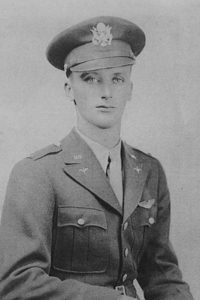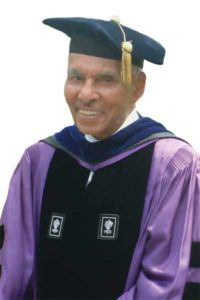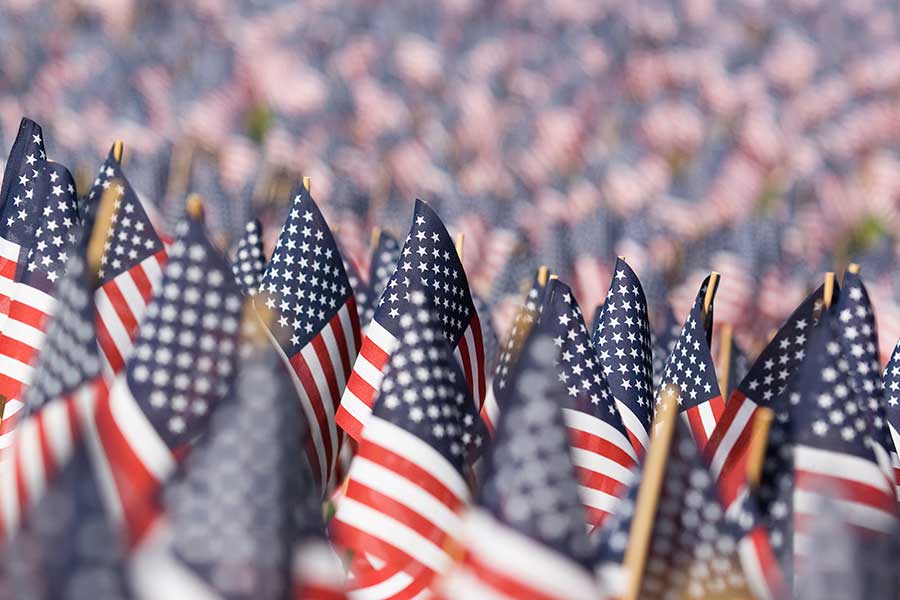Editors’ Note: Attorney James Reid is a long-time friend of Keystone College and a member of Keystone’s President’s Advisory Council. Below is a story of bravery and heroism of two men who served their country during World War II: Mr. Reid’s late uncle and Scranton native Wilson Goodall, and another long-time friend of Keystone, the late Dr. Roscoe Brown, a member the famed Tuskegee Airmen.
We tell their story for Veterans Day to honor them and pay tribute to all men and women who have served our nation.
 U.S. Air Force Pilot 1st Lt. Wilson Goodall
U.S. Air Force Pilot 1st Lt. Wilson Goodall
When 24-year-old U.S. Air Force Pilot 1st Lt. Wilson Goodall completed his bombing run over the skies of Blechhammer in southeast Germany during a mission to destroy a synthetic oil plant on August of 1944, a member of his 10-man crew triumphantly announced over the intercom, “Okay guys, we made it. It’s time to go home.”
When those fateful words were uttered, the crew had more in mind than simply returning to their base in Foggia, Italy. It meant that it was time to go home to their families. Lt. Goodall and most of his crew had just completed their 50th mission, the maximum requirement for aircrews in the 15th Army Air Forces (now U.S. Air Force) at that time. Although the war in Europe would rage on for another year, the 10 members of his bomber squadron were about to return safely from their final mission of the long and bloody war.
The celebration was short lived. Within moments of these remarks, the B-24 bomber, nicknamed, “You Never Had It Better,” was struck by enemy anti-aircraft fire, known as flak, and then exploded and crashed onto the German soil below. Seven of the 10 members aboard, including Lt. Goodall, were killed. An eighth crewman, who dove through the open bomb-bay door, died on the ground from his wounds that night.
Capt. Roscoe Brown, Tuskegee Airmen
In addition to Lt. Goodall, another young man flew a fighter plane on the same mission over Blechhammer. That person was Capt. Roscoe Brown of the 100th Fighter Squadron of the 332nd Fighter Group, better known as the Tuskegee Airmen, the first group of African-American military pilots in U.S. history.
The Airmen became famous for their bravery and success throughout the course of the war, revered for overcoming the segregation and racism they faced serving their country during the most difficult of times.
While it is unclear Lt. Goodall and Capt. Brown knew each other, both men were on the same mission together, Lt. Goodall as a pilot of a B-24 bomber, and Capt. Brown as a pilot of one of the fighter planes that escorted the bombers on that mission.
After developing a friendship with Keystone College President Emeritus Dr. Edward G. Boehm, Jr., Capt. Brown returned to Keystone on several occasions, most notably to receive an honorary degree and to speak at the college’s commencement ceremony in 2009.
Capt. Brown was awarded the Distinguished Flying Cross and Air Medal with eight Gold Leaf Clusters. He is credited with being the first 15th Air Force pilot to shoot down a German jet fighter during air-to-air combat in a raid over Berlin. Among many other awards, he was also honored by the Intrepid Air-Space Museum for his outstanding leadership as squadron commander.
After completing his military service, he earned his Ph.D. from New York University and pursued a successful career in higher education and public service. For over 25 years, he served as a full professor at New York University and founding director of the university’s Institute of Afro-American Affairs. He completed a six-year tenure as president of Bronx Community College of City University of New York (CUNY). Dr. Brown created the Center for Urban Education Policy at CUNY Graduate School and University Center, serving as its director.
As we celebrate Veterans Day, we remember Lt. Goodall, Capt. Brown and all who bravely served our nation as true American heroes in the finest sense of the word.






